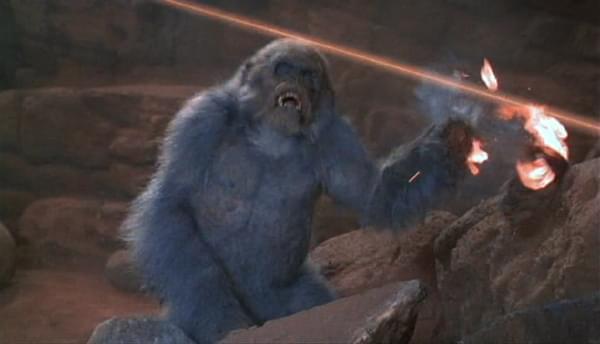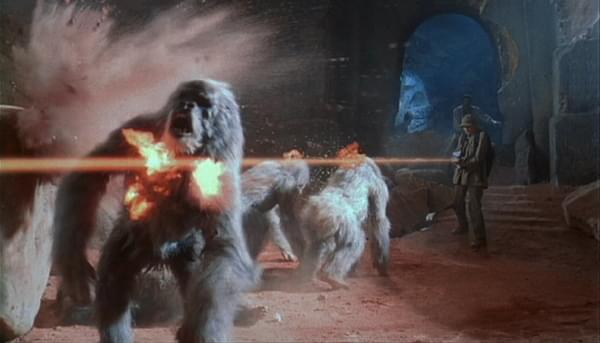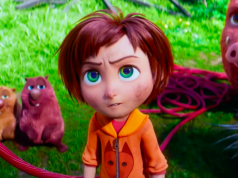
(Note: This column uses the words “ape,” “monkey,” and “gorilla” interchangeably, even though it is technically incorrect to do so. The author apologizes in advance for not caring if this bothers you.)
The only reason to watch “Congo” is to see the climax, when someone uses lasers to set a bunch of monkeys on fire. In fact, while the film was profitable, I submit that it would have been an even bigger hit if it had been released under its working title, “Laser Monkeys.” Oh, and they should have played up the fact that it was based on a Michael Crichton novel, since he was really big in the mid-’90s because of “Jurassic Park.” So: “Michael Crichton’s Laser Monkeys.” Or even better: “Michael Crichton’s Laser Monkeys: Based on a Novel by John Grisham.” Now you’re talkin’!
“Laser Monkeys” is one of the few films in the Eric’s Bad Movies catalog that was actually a box office hit, grossing $81 million in the U.S. and another $70 million in the rest of the world. Moviegoers have always loved stories about the lower primates, from “King Kong” to “Every Which Way But Loose” to “Larry the Cable Guy: Health Inspector,” and when those monkeys are being immolated via laser technology, well, forget about it.
Unfortunately, the parts of the movie that aren’t about using intense beams of coherent monochromatic light to incinerate gorillas are boring. It’s about a group of people venturing into the wilds of Africa for a variety of reasons, some of which are dumber than others but none of which are interesting.
At the better end of the motives spectrum, Dr. Karen Ross (Laura Linney) is looking for a co-worker and ex-boyfriend of hers who went missing while on a diamond-seeking expedition for his father’s corporation. The company needed these diamonds for a special kind of laser gun it’s developing — although, since this is a communications firm we’re talking about, I don’t know why it needs guns of any kind, let alone laser guns. I also don’t know why the gun needs diamonds to function, or why they have to be THESE diamonds, perilously hidden in dangerous, uncharted jungles. I know diamonds aren’t found just lying around in vacant lots or gutters, but obviously there are methods of acquiring them that don’t involve sending men into man-eating-monkey-infested regions of the Congo. For example, you can go to the mall.
Also on this trip is a scientist named Dr. Peter Elliot (Dylan Walsh). He’s gained notoriety at Berkeley for teaching a young gorilla named Amy to talk, even though he has actually done no such thing. What he did was teach her sign language (which had been done many times before), then hook up a machine to her hands that translates her signs and speaks them aloud in a computerized voice. That is not the same thing as teaching a monkey to talk, you’ll agree, but that doesn’t stop one movie character after another from marveling at how at last Dr. Elliot has overcome the speech barrier that separates man from beast. The fact that the machine can somehow tell the difference between an official “sign” and Amy just moving her arms around is particularly impressive, or possibly just stupid.
Peter is bringing Amy back to the place where she was born, on account of she’s been having nightmares and painting pictures of what Peter thinks must be her native jungle, and Peter assumes this means she’s homesick. Peter tends to “assume” a lot of things, and you know what happens when you “assume”: you go to Africa and get attacked by monkeys.
There’s also a Romanian faux-philanthropist (Tim Curry) named Homolka, which always sounds like “jamocha,” like the shake at Arby’s. Homolka is actually flat broke and trying to find a mythical city of diamonds. I don’t remember why he’s in the movie. He doesn’t really do anything. On the second draft, let’s cut him out, OK? I would like a jamocha shake, though.
But before the group can even get to the jungle, first they have to endure a lot of not-very-exciting adventures, such as having their plane shot down by warlords. That might sound exciting, but bear in mind that Karen used to work for the CIA and is capable of using a flare gun to intercept missiles. The group’s guide (Ernie Hudson) is capable of the same thing, despite having had no CIA training, and despite it being impossible. Bear in mind also that when the plane actually goes down, it turns out everyone on board is really, really good at skydiving, despite having had no lessons or even basic instructions, and nobody is injured in the slightest when they bail out. The whole thing turns out to be nothing more than a minor inconvenience.
Then there’s another scene where they’re in a boat on a river and a hungry, hungry hippo attacks them and someone has to shoot it. Again, this might sound thrilling, but bear in mind that the same thing happens on the Jungle Cruise at Disneyland, and that ride has never entertained anyone. It’s not very exciting when the group runs into a herd of giant spinning teacups, either.
They eventually get to the part of the Congo where Karen’s co-workers disappeared. In a very handy coincidence, this area is also Amy’s homeland. It is also very close to the not-mythical-after-all lost city of diamonds. Basically, everything that every character in “Laser Monkeys” needs is in this one spot, like Harry Potter’s Room of Requirement, except even lazier as a storytelling device.
Predictably, Amy’s co-apes aren’t interested in meeting her. Plopping her into the jungle after living most of her life in captivity is like dropping a rich kid into public school, with all the attendant ostracizing and wedgies. Could it be that this was a stupid idea after all???
No, of course not. Peter will have none of that. Instead, he and the group keep Amy with them as they continue looking for Karen’s dead co-workers. Then, finally — FINALLY! — they encounter the deadly monkeys who killed Karen’s people. The only thing that makes them different from regular simians is that they are gray in color and very, very hostile, like Clint Eastwood. This is something of a disappointment, since moviegoers have come to expect dangerous monkeys to be monster-sized. All this suspense and build-up and hippo-shooting and missile-dodging, and THIS is what we get? Regular-sized monkeys that just happen to be angry? Gyp.
They are exceptionally angry, though, I’ll give them that. In keeping with the film’s general theme that humans are awful and animals are sacred, we learn that this particular kind of monkey was bred to kill — specifically, to kill anyone trying to remove diamonds from the ultra-secret diamond mine. It’s the humans’ fault that these monkeys are mean. A similar idea is expressed earlier in “Laser Monkeys,” when someone wonders if Amy is dangerous and Peter says, “People are dangerous. Gorillas are gentle.” Yes, because people are always dangerous, and gorillas are always gentle. It’s that kind of didactic, black-and-white, over-simplified ideology that has made Peter such a successful scientist!
(By the way: If you have a pet gorilla — even a tame one — and she has screaming nightmares, and you try to wake her up and comfort her the way Peter does in this movie, that gorilla will, in fact, in the midst of her primal, irrational terror, rip your arms off and beat you to death with them. And that’s … One to Grow On.)
Just as the death monkeys are surrounding our heroes, menacing them, grunting at them, flinging poo at them in a threatening manner, Karen finds the right diamond to fit the laser gun, activates it, and lights up their gorilla behinds. As I mentioned, this is the film’s only saving grace. As I did not mention until now, after Karen lasers the monkeys, they fall into lava, because, oh, by the way, there’s also a volcano here that’s erupting right now. And then also, by the way, the gorillas that weren’t so keen on meeting Amy before change their minds and befriend her, and Peter leaves her there, presumably so she can live happily ever after, but probably so she can starve to death because she doesn’t know how to find her own food. The end.
— Film.com







